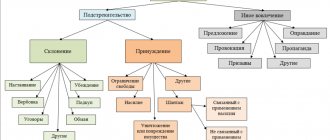Criminal law provides for liability not only of the person who committed the crime, but often also of the person who deliberately persuaded him to make this decision. And in the case when we are talking about such a serious act as murder, the responsibility of the instigator can also be quite great. Let's figure out what the legal role of the instigator is, what exactly constitutes incitement - and what liability the perpetrator faces under Art. 105 using Art. 33 of the Criminal Code of the Russian Federation.
What is incitement to murder?
First, you need to determine what kind of action is called incitement from a legal point of view. To do this, you need to refer to the text of Art. 32 and 33 of the Criminal Code of the Russian Federation. According to their norms, it is possible to commit a crime in the form of complicity - when two or more persons who may be subjects of a crime jointly participate in the commission of an intentional crime.
Important! It is important to pay attention to the term “intentional”. It is very problematic to participate in criminal acts committed through negligence, and it is completely impossible to incite them.
More information about the analysis of the concept of causing death by negligence can be found here.
Complicity itself is expressed in the following types, provided for in Art. 33 of the Criminal Code of the Russian Federation:
- Co-perpetration - when the crime itself is directly committed by two or more people.
- Organization - when someone organizes the commission of criminal acts, manages other criminals, and also when he organizes a criminal group or community.
- Complicity - when the accomplice himself is not directly involved in the crime, but helps with advice, provides tools or tools, removes obstacles in the way of the perpetrator, and also promises in advance to give the criminal shelter or to purchase the obtained valuables from him.
- Incitement is when someone induces another person to commit criminal acts through persuasion, bribery, blackmail, threats or other methods.
When talking about incitement to murder, the following should be kept in mind: the instigator himself does not kill - he bribes, persuades or forces the murderer to commit a criminal act. Thus, the actions of the instigator also pose a danger to society - and that is why criminal law provides for liability for him too. Specifically, incitement is described in Part 4 of Art. 33 of the Criminal Code of the Russian Federation.
Types of participants in a criminal act
An organizer is a citizen who directly organizes a criminal act, coordinating the actions of other participants, as well as a person who creates an organized group of persons, or an association of criminal groups for the purpose of committing crimes.
CALL A LAWYER
HE WILL SOLVE YOUR QUESTIONS FOR FREE Moscow, region 8 (499) 577-00-25 ext. 130 St. Petersburg, region 8 (812) 425-66-30 ext. 130 Federal number 8 (800) 350-84-13 ext. 130
An accomplice is a citizen who assists in the commission of a criminal act through the following actions:
- giving advice and guidance;
- provision of information, means and tools necessary to commit a future crime;
- removing obstacles that prevent the commission of a criminal act;
- concealment of instruments and means used in the commission of a crime, persons involved in it, as well as stolen property of victims.
The perpetrator is a person who directly committed a criminal act alone or as part of a group of other perpetrators, as well as a citizen who committed a crime through the hands of persons exempted from liability by force of law, for example, by involving minors or incompetent citizens.
And finally , instigators are citizens who incline other persons to commit a criminal act by manipulating people through bribery, persuasion, threats, or using other methods of influencing a person.
In this case, the instigator can act through both soft intrusive persuasion, gradually convincing a person or misleading him, and harsh methods of influence, including physical violence, the threat of violence or blackmail. The instigator’s choice of one method or another largely depends on the personality of his victim, her psychological state and life circumstances. For example, deception is often used by the lawyers “involved” in the case to incite false testimony in order to improve the position of the client.
In some cases, it is quite difficult to distinguish between incitement, complicity and organization, since all these forms of participation in a crime have similar characteristics and pursue the same goal.
However, regardless of the degree of participation in the criminal act, these persons are accomplices of the crime committed.
What methods are there?
In practice, the instigator can carry out his actions in various ways . In first place in terms of prevalence among them is bribery. In this case, the instigator promises the future murderer to pay a certain amount of money or transfer some valuable property if the crime is committed. Criminal liability in this case is distributed as follows:
- The killer will be liable under paragraphs. “g” and “h” part 2 art. 105 of the Criminal Code of the Russian Federation (murder committed by prior conspiracy for mercenary reasons or for hire).
- Instigator – on the same counts, but using Part 4 of Art. 33 of the Criminal Code of the Russian Federation.
Another way would be persuasion. In this case, the criminal does not receive any material benefit from his actions and commits murder for other reasons. The specific form in which persuasion should take place is not established by law.
In addition, the instigator can also act through threats . In this case, the criminal commits the murder of another person at the will of the instigator in order to avoid any negative consequences for himself. Threats may relate to the life of the criminal himself or his loved ones, to his property, health, etc.
The main difference between threats and persuasion is that with persuasion the role of the direct executor is more active. Accordingly, when sentencing a murderer, this difference must be taken into account. Moreover, if the threat was significant enough, the perpetrator may generally avoid punishment in accordance with Art. Art. 39 and 40 of the Criminal Code of the Russian Federation.
According to its norms, an action carried out under duress and in a state of extreme necessity is not considered a crime - and in some circumstances, a threat to the life and health of the person forced to commit murder, or his loved ones, may be considered as an extreme necessity.
Attention! The law establishes an open list of ways in which incitement can be expressed.
This is due to the fact that when a clearly defined list is established, those persons who incite the commission of a crime (in particular, murder) in ways that are not directly named in the law will escape responsibility. Since criminals often have a rich imagination, this situation is almost inevitable.
Punishment for the organizer
The organizer of a crime is a person who is active in everything related to preparation for committing an offense.
Such an event participant can have two roles:
- direct participant;
- The role of only the organizer.
With direct participation, the criminal carries out the organization primarily on his own, develops a plan for the proposed act, determines the role of each participant, if there are several of them, and also determines his role in participation. If the organizer only intends to develop a plan, then he does not participate in the process itself, but at the same time manages the process completely, communicating with other participants in ways available to him.
The punishment of this accomplice will be determined in accordance with the obligations assumed, since offenses may vary in severity, but the terms of the name are subject to change.
Also, when assigning a measure of responsibility, the identity of other people who are part of the company that committed the offense is taken into account:
- Minors.
- Incapacitated.
- Mentally ill, but not incapacitated.
In this case, the organizer, even if he did not participate in the crime, is recognized as the direct perpetrator, since he influenced other accomplices thanks to his strength, both physical and intellectual, and also suppressed the weaker ones and essentially forced or incited them to act as he pleased.
Main differences from other forms of complicity
Incitement correlates with other forms of complicity provided for in Art. 33 of the Criminal Code of the Russian Federation , as follows:
- Unlike co-perpetrator, the instigator does not directly participate in the commission of the crime.
- Unlike organization, the instigator only encourages the criminal perpetrator to commit his act, but does not organize the process of criminal actions. He does not plan the commission of a crime, does not distribute roles between other accomplices, but only persuades the perpetrator to act.
- Unlike aiding and abetting, the instigator does not provide any assistance to the perpetrator - he acts independently.
In addition, the instigator participates in the execution of the objective side of the crime, while the accomplice does not. The main difference between these two forms of complicity is the following: the instigator arouses the desire in the perpetrator to commit a crime, and the accomplice helps to realize this desire. In the case of intellectual complicity (when an accomplice gives the perpetrator specific recommendations and advice on how exactly to commit a crime), the difference from incitement will be whether these tips and recommendations prompted the commission of the act, or only helped it to be realized.
Comments on Article 33 of the Criminal Code of the Russian Federation
When talking about the role of the instigator, you need to remember the following:
- Some legal theorists believe that incitement is possible not only in relation to the perpetrator, but also to other accomplices. For example, an instigator may push an organizer to create a criminal group that will directly commit murder. As of the beginning of 2022, there is no clear practice on this issue, and the Supreme Court of the Russian Federation has not yet clearly expressed its position.
- In some cases, the instigator may be a co-perpetrator of the murder. However, if such a situation occurs, there will be no talk of incitement - both accomplices will be held accountable directly under the relevant provisions of Art. 105 of the Criminal Code of the Russian Federation.
- The incitement must be directed towards the commission of a specific crime. When talking about murder, the person must be pushing for the death of the victim. General words (such as: “Finally deal with him,” “It’s time to get even,” etc.) usually cannot be considered as complicity in murder.
- Also, incitement must be directed at a specific person. The same calls to kill someone, but addressed to an indefinite circle of people, cannot be considered as incitement to commit murder.
How to properly understand the process of incitement?
This type of crime refers to complicity in murder. A variety of methods can be chosen, for example:
- requests and persuasion;
- misrepresentation;
- bribe;
- threats to create trouble or harm loved ones;
- blackmail;
- use of physical force;
- provocation to commit a crime with the aim of exposing the perpetrator.
There are different methods of incitement. It depends on the psychological characteristics of the alleged killer.
The actions of a person are recognized as incitement not only on the basis of the consent of the perpetrator to commit a crime, but also when the perpetrator proceeds to the corresponding illegal actions.
Corpus delicti
Speaking about Art. 33 of the Criminal Code of the Russian Federation, you need to remember that it is reference. Ultimately, the guilty person will be punished under Art. 105, and art. 33 and others will be used only when determining the amount of punishment. Nevertheless, speaking about the instigator, we can identify the same elements of the crime as in the murder itself. They will be:
- Subject is a person who is sane and has reached the age of criminal responsibility (specifically in this case - 14 years).
- The subjective side is a person’s attitude towards committing criminal acts. When talking about incitement to murder, we must remember that it is expressed in deliberate actions. You cannot incite unintentionally.
- The object is the same as in murder, human life.
- The objective side is the direct actions of the guilty person. Since we are talking about complicity, the objective side will be to create a motivation for the perpetrator to commit murder. It is illegal to incite murder by omission, although omission in certain circumstances may be considered complicity.
Arbitrage practice
Unfortunately, judges often have to consider cases where Article 110 of the Criminal Code appears. Society does not have time to shudder from cases when it learns that the next suicide is a teenager who fell under the influence of the “death group” on VKontakte. Typical cases include the following:
- Driving a person of retirement age to suicide in order to obtain an inheritance or otherwise take possession of his savings. Many residents of Yekaterinburg remember the case when fraudsters fraudulently took away all the savings amounting to almost sixty thousand rubles from an old man, who was 91 years old at that time. The pensioner could not survive this shock and committed suicide.
- Pregnant women.
- Teenagers.
Examples
The role of the instigator is easier to understand using concrete examples..
So, for example, in 2011, the Supreme Court of the Republic of Karelia considered a case with the following plot. A., wanting to commit the murder of R., acted as an organizer.
He transferred money to the convicted B., so that he, acting as an intermediary, would persuade K. to commit murder through bribery. B., carrying out criminal intent, met with K. and, with the help of both bribery and threats, persuaded the latter to participate in the murder of R. The murder took place, B. received money from A.
Later, based on the results of the investigation of the case, he was convicted as an accomplice of A. and instigator of K.
As an example when a person’s actions were erroneously classified as incitement , we can mention the Byashimov case, considered in 1967 (unlike other branches, the fundamental principles of criminal law have changed little since the times of the USSR). This citizen was convicted by the court of first instance as an instigator of murder.
His actions were expressed in the fact that he wrote to his brother, who was serving in the army at that moment, about the immoral actions of his wife. Returning home, his brother committed murder and was convicted for it, and Byashimov was brought in as an instigator.
However, the Judicial Collegium for Criminal Cases of the USSR Supreme Court acquitted the convict, pointing out that Byashimy’s actions did not specifically induce the killer to commit a crime. The information he conveyed to his brother led to the commission of a crime, but the convict had no intent to kill the victim.
Provocation of a bribe, incitement and falsification of the results of the operational investigation. Lawyer's recommendations
According to Article 5 of the Federal Law of August 12, 1995 No. 144-FZ “On Operational Investigative Activities”, bodies (officials) carrying out operational investigative activities are prohibited from inciting, inducing, inducing in direct or indirect form to commit illegal actions (provocation) , as well as falsify the results of operational-search activities (hereinafter referred to as ORM). However, practice knows examples when violations of the law were committed in relation to persons brought to criminal liability in cases of bribery (Article 290 and Article 291.1 of the Criminal Code of the Russian Federation) - inflammatory actions were committed, provocations were arranged and the results of the operational investigation were falsified.
Examples of incitement and provocation of a bribe.
Let's look at some examples from judicial practice that contain signs of incitement and provocation of a bribe, as well as falsification of the results of operational investigations.
1. The briber is an agent of law enforcement agencies. The approach to the official is carried out through mutual acquaintances and (or) by positioning the agent as a large out-of-town businessman, whose “help” from the official will bring material benefits to the latter. During repeated conversations, the agent convinces the official to accept the bribe, and when it is handed over, he is detained. In this situation, the official’s intention to take a bribe was formed not independently, but under the influence of an agent. If it were not for the latter’s inciting actions, the bribe would not have taken place. In the above example, receiving a bribe does not constitute a crime and the bribe-taker is subject to release from liability.
2. The official is given a case with documents. But instead of documents it contains money. Upon receipt of the case, the official is delayed. The provocation lies in the fact that the official is deliberately misled about the contents of the case and only therefore accepts it. To create the appearance of a bribe, the case is handed over by an agent who speaks a pre-prepared text over an audio recording: “I brought it to you,” “as we agreed,” “as you asked,” etc. Thus, not only a provocation of a bribe is committed against an official in the form of transferring money without his consent, but also falsification of the results of the operational investigation, since he did not have the intent to receive a bribe.
If there is a case with money seized from the detainee, a coincidence of traces of paint on the case and on his hands, the testimony of the agent, audio and video recording of the transfer of the case, there is a high probability of a guilty verdict. Confessions about receiving a bribe, given under the “gravity of evidence” or “guarantees” of mitigating the preventive measure, the amount of punishment, will only strengthen the position of the prosecution.
3. The return of a really existing large debt is framed as the transfer of a bribe. When receiving money, the creditor, who is also an official, is detained as a suspect under Part 6 of Article 290 of the Criminal Code of the Russian Federation. This example is a more complex combination in the form of a bribe provocation, built by operatives.
Firstly, the debt obligations actually existed. But before the debt was repaid, the debtor proactively came into contact with the operatives. Everyone has their own interest: the debtor has the goal of avoiding repayment of the debt by accusing the creditor of taking a bribe, and unscrupulous law enforcement officers have the goal of solving a high-profile crime, since the creditor is a major government official. For this purpose, the debtor began to receive instructions and means of covert audio and video surveillance to record his conversations. All this was done informally, i.e. illegal.
Secondly, in order to repay the loan issued, the creditor is forced to communicate with the debtor and must accept the debt from him. In conversations, the debtor, being an agent, began to further incite the creditor to receive a bribe for resolving an issue not related to debt obligations in favor of a third party. Thus, the situation turned out to be ambiguous. It is not clear from the content of the conversations what the money was transferred for: partial repayment of a debt or as a bribe?
In the example considered, the provocation of a bribe was carried out by an agent - the “bribe taker” did not have the intention of receiving a bribe, he only intended to collect the debt. The falsification of the results of the operational investigation was reflected in the fact that the return of part of the debt, the existence of which the operational workers knew, was documented by them as a bribe. At the same time, the official avoided conversations about a bribe imposed on him and perceived the money transferred to him as a partial repayment of the debt.
The courts actually proceed from the presumption of the legality of the actions performed by operatives until the contrary is proven. The author’s personal experience and judicial practice show that countering provocation and falsification of the results of operational investigations in bribery cases is a difficult but feasible task. The author sought to have the court declare the evidence obtained during the operational investigation inadmissible in accordance with Article 75 of the Code of Criminal Procedure of the Russian Federation and to issue an acquittal.
General recommendations of a lawyer when inciting or provoking a bribe.
For an official there is always a risk of incitement or provocation of a bribe being committed against him. To minimize the risk of provoking a bribe, I recommend the following.
A. Caution should be exercised in contacts with people. To weaken your vigilance, they will send a provocateur, providing him with recommendations from people you know well.
B. Pay close attention to what your interlocutor says. If the content of his phrases is unclear to you and is ambiguous, then under no circumstances take anything from him. Say directly and loudly that you do not understand his words. Surely he is secretly recording the conversation. In the future, the lawyer will be able to use it as evidence of your innocence. On the contrary, silence can be construed against you.
B. Do not allow the following phrases to be expressed: well, what did you bring, what have you got there. Conspiracy measures will not help: did you bring newspapers, booklets, etc.? The agent provocateur will testify that you used the words “newspapers” and “booklets” for the purpose of conspiracy, but in reality it was about a bribe. The investigation and the court will probably agree with him and you will be found guilty of taking a bribe.
D. If the interlocutor is trying to put some object on the table, then ask him what kind of object it is. Do not touch it and call witnesses immediately. Every second counts, since there are probably operatives behind the door.
General recommendations of a lawyer if incitement or provocation of a bribe took place.
If the incitement or provocation of a bribe is successful and you are caught red-handed, I recommend the following.
A. Calm down. Do not fall for promises that in exchange for confessing to taking a bribe you will be allowed to go home. Will not let go. The article under which you were detained belongs to the category of grave, especially grave (depending on the size of the bribe). If you give in to persuasion, you will get home in a few years.
B. Ask for a lawyer immediately and refuse to testify until he arrives. The lawyer must be proven. Someone you trust. Don’t settle for something “free”, much less something recommended by those who detained you. Surely, the lawyer invited on their recommendation will begin to work not for you, but for them: he will convince you to admit to receiving a bribe. Also keep in mind that deception is possible - they will claim that their lawyer was invited on behalf of your wife or friends.
B. With the participation of a lawyer, do not rush to admit your guilt in receiving a bribe. You will always have time to do this. Together you should understand what incriminating evidence the investigation has that you received a bribe. You should confess when the investigator has collected enough evidence and the “guarantee” of changing the preventive measure to a more lenient one or reducing the punishment is not an empty phrase, but a reality. Otherwise, there is no need to rush to admit guilt. It is difficult, while in a pre-trial detention center, not to succumb to various persuasion. But after this, it will become almost impossible to prove incitement, provocation of a bribe and falsification of the results of the operational investigation.
Defense tactics in cases of incitement or provocation of a bribe.
The prosecution in bribery cases is mostly based on evidence obtained as a result of the operational investigation. All other evidence of the commission of a crime is derivative. If a lawyer can prove the illegality of the operational operations and the evidence obtained during their implementation, instigation or provocation of a bribe and falsification of evidence, then this is a direct path to an acquittal!
1. By virtue of Part 7 of Article 8 of the Federal Law of August 12, 1995 No. 144-FZ “On Operational Investigative Activities,” an operational experiment is carried out on the basis of a resolution approved by the head of the body carrying out operational investigative activities. Therefore, carrying out an operational investigation against an official before the relevant decision is made is illegal, and the evidence obtained in this case is inadmissible.
2. To obtain information about connections between subscribers and (or) subscriber devices (identification of subscriber devices - determining IMEI and (or) subscriber number), as well as determining the location of the telephone set relative to the base station, a court decision is required. Therefore, the specified information, recordings of telephone conversations, electronic correspondence, etc., received in his absence. are inadmissible evidence and cannot be used as the basis for a bribe conviction.
3. If, before conducting an operational-search activity “operational experiment,” law enforcement agencies have no reason to suspect an official of bribery, and the receipt of a bribe was the result of the intervention of operative workers (transfer of a bribe by an agent), then their actions are incitement or provocation.
4. One of the difficult tasks facing the defense when inciting, provoking a bribe and falsifying evidence is obtaining information that the bribe-giver was an agent. It is still possible to obtain such information. When there is information that this person has previously taken part in operational investigations in cases unrelated to the crime under investigation. Such information can also be obtained by analyzing the location of a telephone set relative to the base station (details of telephone connections of its telephone number (billing)), before and after receiving and transmitting a bribe. Thus, in one of the cases, based on billing, it was established that the bribe-giver entered into informal contacts with operatives long before the start of operational-search activities. In combination with other arguments, the author managed to prove the commission of provocation of a bribe and falsification of evidence in relation to his client.
5. The decision to participate in operational-search activities must be made voluntarily by the citizen. In practice, this legal requirement is not always observed. The forced nature of participation in the operational investigation deprives the evidence obtained of the sign of admissibility. Thus, in one case related to provocation of a bribe, the author proved that the bribe-giver participated in an operational experiment against his will. Shortly before this, he was detained on suspicion of committing another crime and was offered to take part in an experiment involving the transfer of a bribe in exchange for release from criminal liability.
6. Of great importance in cases of incitement, provocation of a bribe and falsification of the results of operational investigations are the audio and video recordings of conversations of witnesses, intermediaries, and most importantly, the bribe giver and bribe taker in the criminal case. From their content, it is possible to establish the presence or absence of corpus delicti in the actions of the parties, incitement or provocation of a bribe. The key question when analyzing their content is who took the initiative to transfer the bribe. If an official’s intention to receive a bribe was formed without the influence of operational workers (agent), then the bribe is obvious. If under their influence, then these actions should be considered not as receiving a bribe, but as incitement to receive a bribe.
7. The bribe lawyer needs to listen to all audio recordings of conversations available in the case and compare their contents with the transcript obtained during the linguistic and (or) phonoscopic examination. The author was faced with a situation where an expert falsified the results of an examination: he substituted individual words, thereby distorting the semantic meaning of the conversation between the persons involved in the case in favor of the prosecution.
When conducting an examination, the investigation uses various tricks. The examination may be entrusted to an expert body that is part of the same department as the preliminary investigation body. This violates the principle of expert independence. Not all audio recordings are provided to the expert for examination, but only a part of them that confirms the prosecution’s arguments. Thus, the expert is provided with an audio recording containing a demand for a bribe. And the expert did not examine the recording of the agent provocateur persuading the official to accept a bribe (it would be a great success for the defense if such an audio recording ended up in the case). These manipulations are aimed at giving legality to bringing an official to criminal liability and at concealing evidence of incitement or provocation of a bribe committed against him, as well as falsification of the results of operational-search activities.
8. Recordings of conversations within the framework of computer technical forensics should be examined for the presence or absence of signs of editing. The expert’s conclusion about the absence of signs of installation must be categorical. Otherwise, the doubts that arise must be interpreted in favor of the accused.
9. No less important is the answer to the question of what technical means were used to record the negotiations on which the charges were based. In one of the cases, the author established that long before the start of operational search activities, the provocateur recorded his conversations using covert audio and video surveillance. The court found these recordings were obtained in violation of the Code of Criminal Procedure.
The format of this article does not allow us to disclose all methods of defense in cases of incitement, provocation of a bribe and falsification of the results of operational investigations. To fully understand them, the author recommends studying the practice of the European Court of Human Rights (ECtHR) and the Supreme Court of the Russian Federation. It is necessary to study not only the practice of bribery and commercial bribery, but also the sale of narcotic drugs, since the methods of conducting operational investigations in the investigation of these types of crimes, as well as the methods of incitement, provocation and falsification, have significant similarities.
Proving the commission of incitement, provocation and achieving an acquittal is an extremely difficult task. Its successful solution is impossible without a lawyer’s thorough knowledge of the materials of the criminal case, and most importantly, the ability to think outside the box. It is also important that he is not afraid to go into conflict with the prosecution or the court if this is necessary in the interests of the client. The goal of a lawyer is not to please anyone, but to win. Victory loves the brave and skillful!
Discrimination from similar crimes
Incitement in itself is not a crime . It is only the form in which the guilty person participates in criminal activity (in our case, murder). Therefore, talking about delimitation from other elements of crime is not entirely correct.
However, we may be talking about distinguishing the role of the instigator from other accomplices in the murder. Therefore, it is necessary to distinguish between his role and the role of a co-executor, accomplice or organizer. The main difference between them is the following:
- It is impossible to be both an instigator and a co-principal - the co-principal will be held accountable separately, since his actions already contain the full corpus delicti.
- It is also impossible to act as an organizer at the same time - the activities of the organizer also include pushing the perpetrator to kill. There is no need to talk separately about incitement in this case.
- An instigator always commits a crime through action , but an accomplice can also participate through inaction (for example, by not fulfilling his duties and thereby making it easier for the killer to commit a crime). However, it is possible to participate in a crime as both an accomplice and an instigator. In this case, the actions will be qualified simultaneously under the relevant parts of Art. 33 of the Criminal Code of the Russian Federation.
What is considered incitement to suicide?
This act can be carried out in different ways. The most common of them are the following:
- humiliation, ridicule and even beatings committed in public;
- suggestion of suicidal thoughts through video and audio with elements of hypnosis;
- blackmail;
- impending threat to loved ones;
- bullying;
- inclination to suicide through games;
- publication of compromising evidence on a virtual network, transfer to authorities, etc.
As you can see, you can push a person to commit suicide in different ways. Among them there are also those that can be almost impossible to prove in court proceedings. Therefore, some criminals resort to this method of “eliminating” a person. Statistics show that the largest number of people who are subjected to such provocations are teenagers. At this age, grown children have not yet had time to develop a stable psyche. Also included in the risk category are pensioners and business representatives.
Responsibility under Art. 105 of the Criminal Code of the Russian Federation and other articles
Usually the instigator is liable under the relevant paragraph of Art. 105 with reference to Art. 33 of the Criminal Code of the Russian Federation . However, situations are possible when a person who actually acts as an instigator will be held liable under one of the articles and without reference to Art. 33:
- The instigator is also a co-perpetrator. In this case, he will only be liable under Art. 105 of the Criminal Code of the Russian Federation.
- Incitement itself constitutes a separate offense.
The last one needs special attention. The offenses where incitement to murder is an independent crime include:
- Art. 150 of the Criminal Code of the Russian Federation - if a minor is involved in the crime as a perpetrator, and the instigator has reached 18 years of age. Depending on the specific circumstances of the case, the perpetrator will face up to 8 years.
- Art. 205.1 of the Criminal Code of the Russian Federation - if the murder is a terrorist act. In this case, the instigator faces a sentence of up to 20 years (depending on the circumstances of the case and the applicable part of the article).
- Art. 228.1 of the Criminal Code of the Russian Federation - if drugs were used to bribe the performer. The punishment will be up to 15 years.
- Part 1.1 art. 282.2 of the Criminal Code of the Russian Federation - if the murder was committed by a member of an extremist organization into which he was involved by the instigator. In this case, the instigator faces a penalty of imprisonment for a term of 4 to 8 years.
- Part 2 art. 361 of the Criminal Code of the Russian Federation - if the perpetrator is incited to commit an international terrorist act. Punishment – from 8 to 20 years.
Reference! Simply put, if the instigator is also a co-perpetrator, then liability threatens under Art. 105 of the Criminal Code of the Russian Federation, from 6 to 15 years of imprisonment, or from 8 to 20 or life in the case of murder with aggravating circumstances.
If the instigator is simply an instigator - similarly under Art. 105 of the Criminal Code of the Russian Federation, but with reference to Article 33 of the Criminal Code of the Russian Federation (this means that it is possible (!) the term will be less). In other cases (when a separate composition is formed) - based on the norms of a specific article (read in the list above).
It will be useful for the reader to read other materials about different types of murders:
- under extenuating circumstances;
- suicide;
- murder by a minor;
- crime while intoxicated;
- killing a person and punishment for it;
- causing the death of a child;
- euthanasia.
Responsibility for a bribe
The Criminal Code of the Russian Federation for incitement to give a bribe, where the citizen acts as a formal intermediary, provides for the following types of punishment:
- a fine reaching 500 thousand rubles, three or five times the size of the bribe;
- forced labor for up to a year;
- correctional labor for up to 2 years;
- deprivation of the right to hold positions in certain areas for up to 5 years.
If responsibility for incitement is provided within a group where everyone has been assigned their own role, the punishment can be harsher - fines of up to 4 million rubles are provided, as well as the possibility of imprisonment for a term of 7 to 12 years. All capable citizens over the age of 16 are subject to liability. There are all the signs of an offense being committed if at least part of the bribe was handed over in front of witnesses.
The punishment can be eased by admitting one’s own guilt, assistance in the investigation, as well as sincere repentance for the crime committed and the citizen’s absence of previous convictions, as well as the presence of young children.
| Pass during quarantine | Payment and registration of sick leave during quarantine |
| Article 6.3 of the Code of Administrative Offenses | Article for violating the self-isolation regime |
- Didn't find the answer to your question? Find out how to solve exactly your problem - call right now:
- Federal number -
- Moscow region, Moscow -
- Leningr. region, St. Petersburg -
- It's absolutely free and fast!








